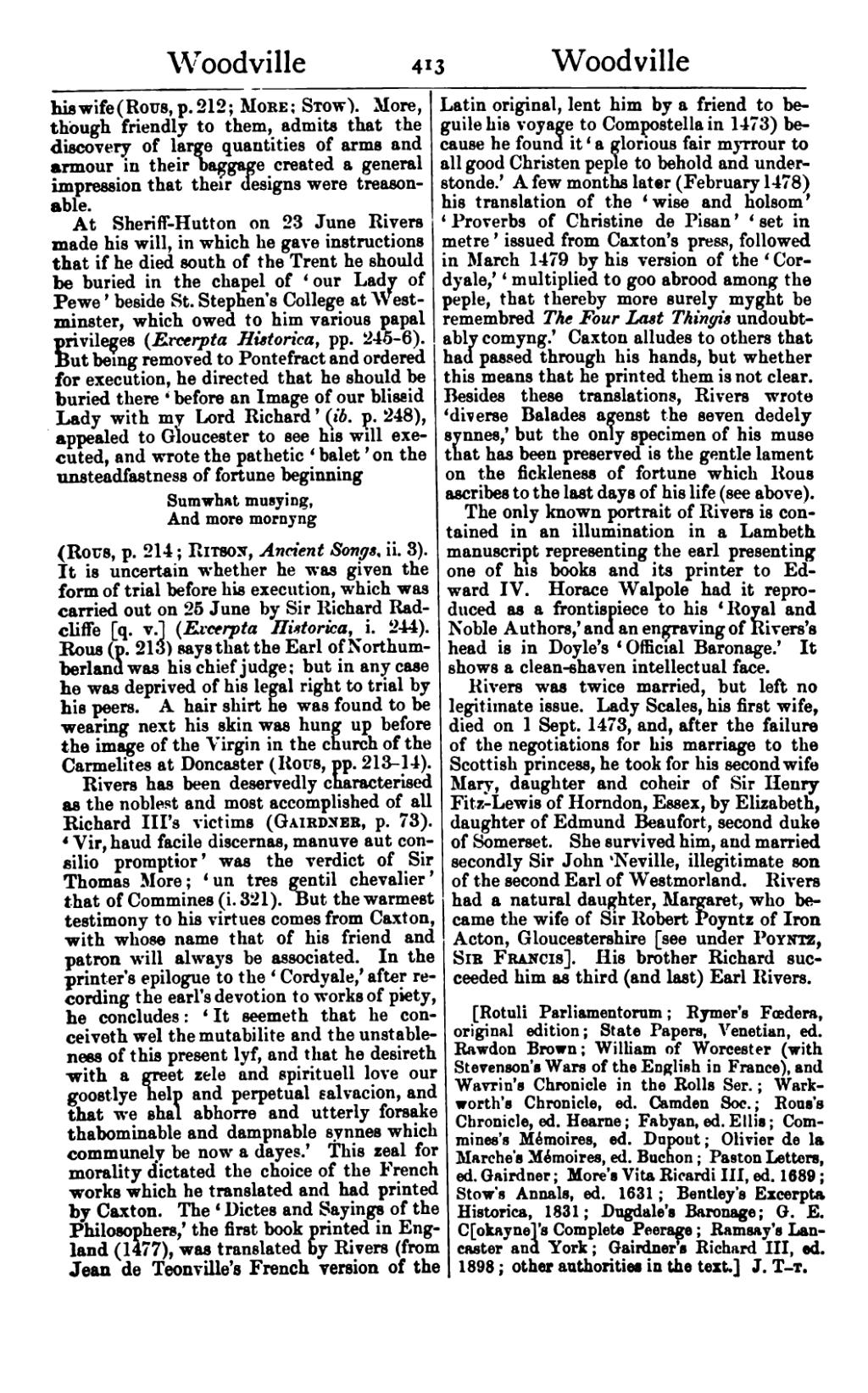his wife (Rous, p. 212; More; Stow). More, though friendly to them, admits that the discovery of large quantities of arms and armour in their baggage created a general impression that their designs were treasonable.
At Sheriff-Hutton on 23 June Rivers made his will, in which he gave instructions that if he died south of the Trent he should be buried in the chapel of ‘our Lady of Pewe’ beside St. Stephen's College at Westminster, which owed to him various papal privileges (Excerpta Historica, pp. 245–6). But being removed to Pontefract and ordered for execution, he directed that he should be buried there ‘before an Image of our blissid Lady with my Lord Richard’ (ib. p. 248), appealed to Gloucester to see his will executed, and wrote the pathetic ‘balet’ on the unsteadfastness of fortune beginning
Sumwhat musying,
And more mornyng
(Rous, p. 214; Ritson, Ancient Songs, ii. 3). It is uncertain whether he was given the form of trial before his execution, which was carried out on 25 June by Sir Richard Radcliffe [q. v.] (Excerpta Historica, i. 244). Rous (p. 213) says that the Earl of Northumberland was his chief judge; but in any case he was deprived of his legal right to trial by his peers. A hair shirt he was found to be wearing next his skin was hung up before the image of the Virgin in the church of the Carmelites at Doncaster (Rous, pp. 213–14).
Rivers has been deservedly characterised as the noblest and most accomplished of all Richard III's victims (Gairdner, p. 73). ‘Vir, haud facile discernas, manuve aut consilio promptior’ was the verdict of Sir Thomas More; ‘un tres gentil chevalier’ that of Commines (i. 321). But the warmest testimony to his virtues comes from Caxton, with whose name that of his friend and patron will always be associated. In the printer's epilogue to the ‘Cordyale,’ after recording the earl's devotion to works of piety, he concludes: ‘It seemeth that he conceiveth wel the mutabilite and the unstableness of this present lyf, and that he desireth with a greet zele and spirituell love our goostlye help and perpetual salvacion, and that we shal abhorre and utterly forsake thabominable and dampnable synnes which communely be now a dayes.’ This zeal for morality dictated the choice of the French works which he translated and had printed by Caxton. The ‘Dictes and Sayings of the Philosophers,’ the first book printed in England (1477), was translated by Rivers (from Jean de Teonville's French version of the Latin original, lent him by a friend to beguile his voyage to Compostella in 1473) because he found it ‘a glorious fair myrrour to all good Christen peple to behold and understonde.’ A few months later (February 1478) his translation of the ‘wise and holsom’ ‘Proverbs of Christine de Pisan’ ‘set in metre’ issued from Caxton's press, followed in March 1479 by his version of the ‘Cordyale,’ ‘multiplied to goo abrood among the peple, that thereby more surely myght be remembred The Four Last Thingis undoubtably comyng.’ Caxton alludes to others that had passed through his hands, but whether this means that he printed them is not clear. Besides these translations, Rivers wrote ‘diverse Balades agenst the seven dedely synnes,’ but the only specimen of his muse that has been preserved is the gentle lament on the fickleness of fortune which Rous ascribes to the last days of his life (see above).
The only known portrait of Rivers is contained in an illumination in a Lambeth manuscript representing the earl presenting one of his books and its printer to Edward IV. Horace Walpole had it reproduced as a frontispiece to his ‘Royal and Noble Authors,’ and an engraving of Rivers's head is in Doyle's ‘Official Baronage.’ It shows a clean-shaven intellectual face.
Rivers was twice married, but left no legitimate issue. Lady Scales, his first wife, died on 1 Sept. 1473, and, after the failure of the negotiations for his marriage to the Scottish princess, he took for his second wife Mary, daughter and coheir of Sir Henry Fitz-Lewis of Horndon, Essex, by Elizabeth, daughter of Edmund Beaufort, second duke of Somerset. She survived him, and married secondly Sir John Neville, illegitimate son of the second Earl of Westmorland. Rivers had a natural daughter, Margaret, who became the wife of Sir Robert Poyntz of Iron Acton, Gloucestershire [see under Poyntz, Sir Francis]. His brother Richard succeeded him as third (and last) Earl Rivers.
[Rotuli Parliamentorum; Rymer's Fœdera, original edition; State Papers, Venetian, ed. Rawdon Brown; William of Worcester (with Stevenson's Wars of the English in France) and Wavrin's Chronicle in the Rolls Ser.; Warkworth's Chronicle, ed. Camden Soc.; Rous's Chronicle, ed. Hearne; Fabyan, ed. Ellis; Commines's Mémoires, ed. Dupont; Olivier de la Marche's Mémoires, ed. Buchon; Paston Letters, ed. Gairdner; More's Vita Ricardi III, ed. 1689; Stow's Annals, ed. 1631; Bentley's Excerpta Historica, 1831; Dugdale's Baronage; G. E. C[okayne]'s Complete Peerage; Ramsay's Lancaster and York; Gairdner's Richard III, ed. 1898; other authorities in the text.]
